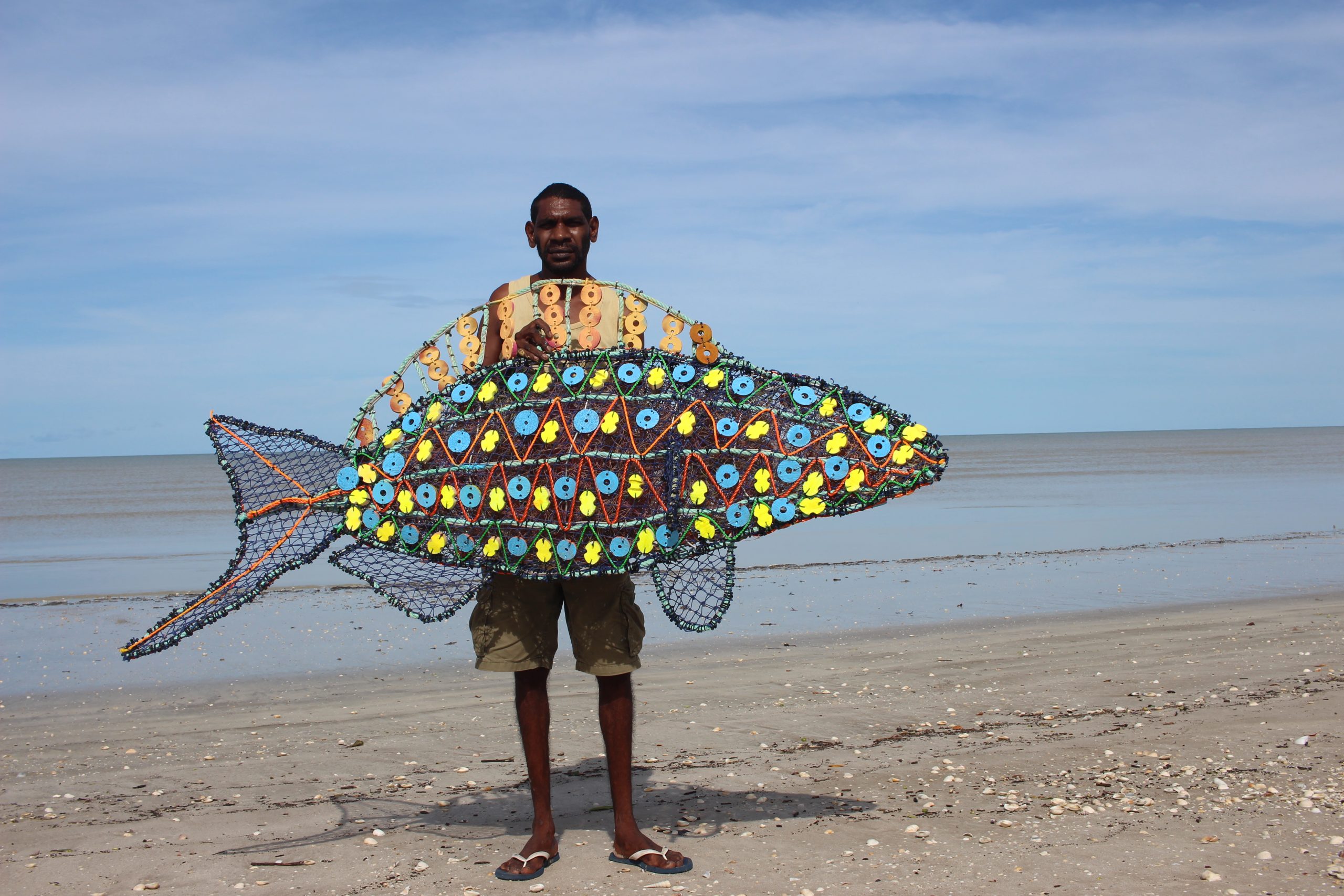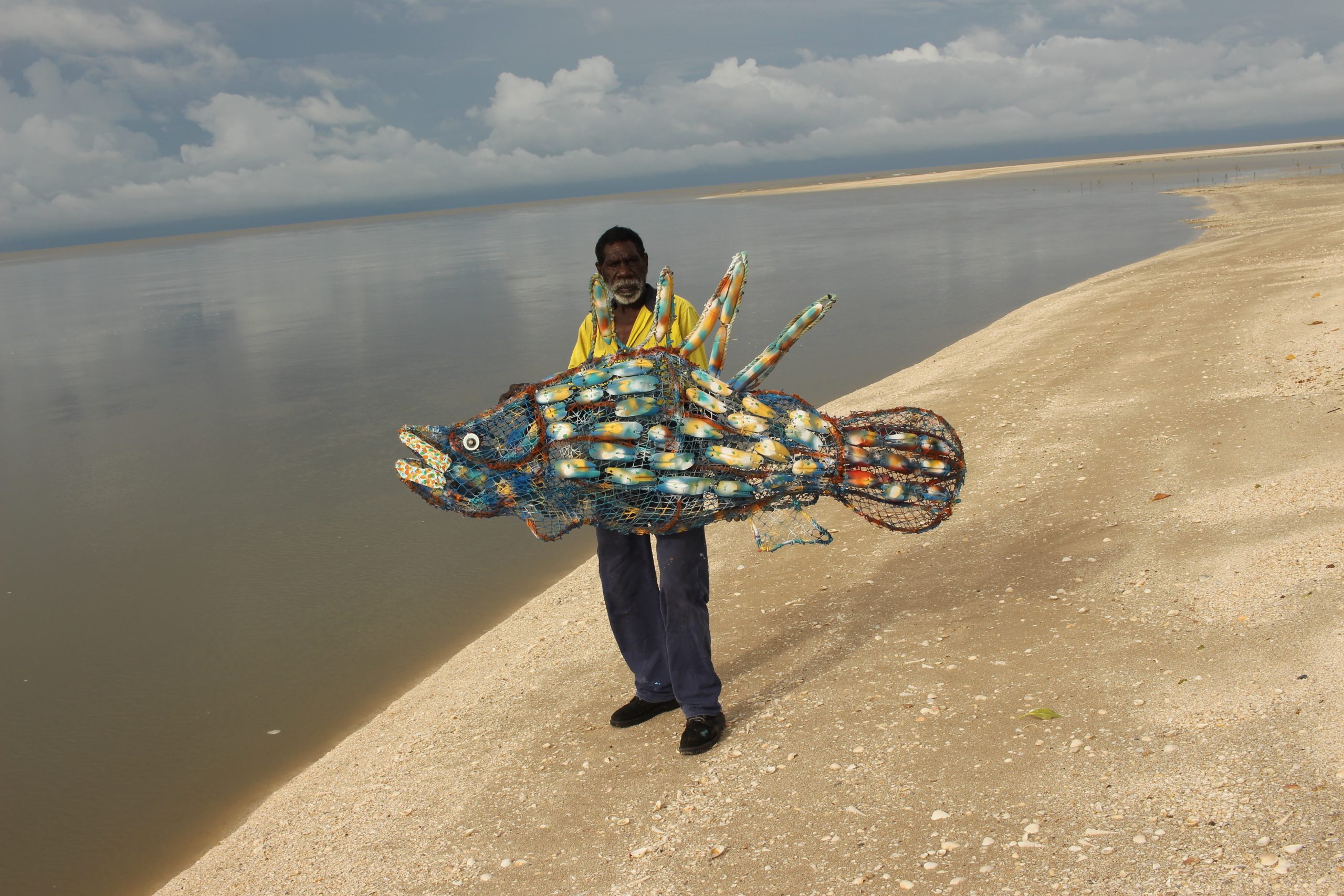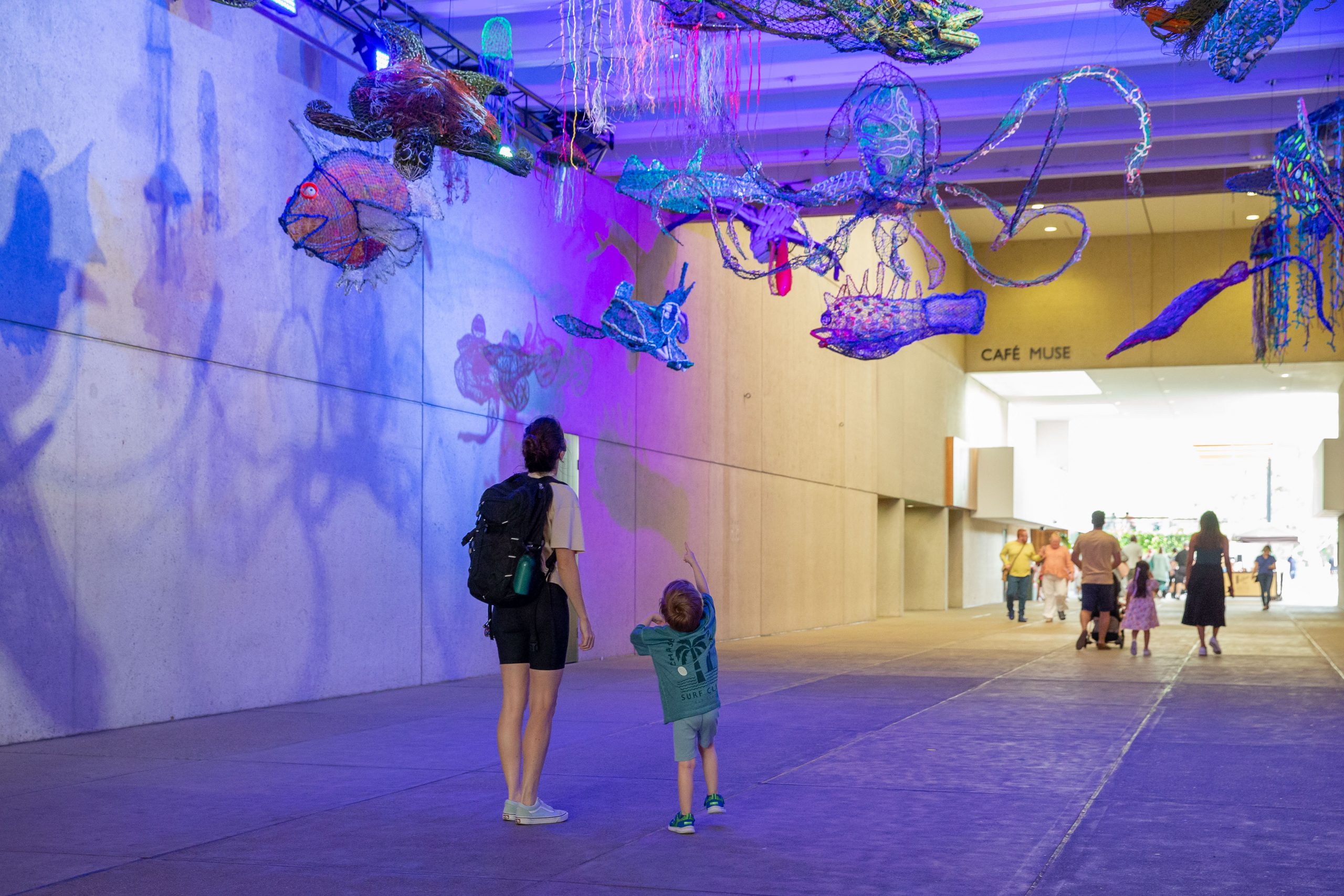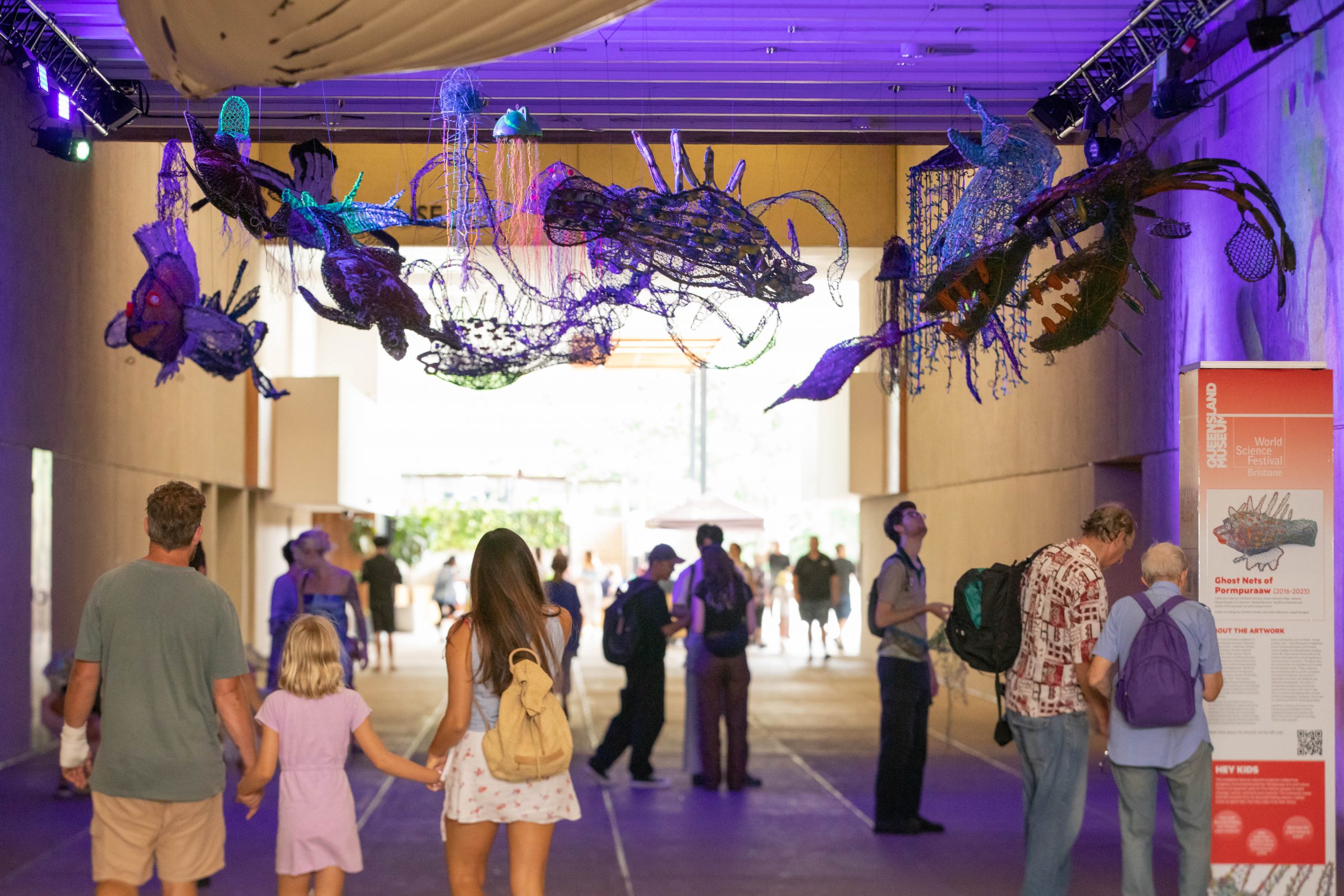Pormpuraaw Art and Culture Centre is a flourishing First Nations creative hub on the western coast of Queensland’s Cape York Peninsula. For a decade, the Pormpuraaw artist community has deftly crafted stunning sculptures out of salvaged fishing waste from the Gulf of Carpentaria. Seaborne detritus such as fishing line, nets and floats – known as ‘ghost nets’ – travel thousands of kilometres across international waters and threaten ocean ecologies by indiscriminately tangling marine life. Many species threatened by this pollution hold important cultural significance and connection to ancestors. The ghost nets are retrieved from the shoreline and recycled by Pormpuraaw artists. These sculptures are synonymous with an artistic movement of several First Nations communities in Queensland, and many are exhibited and collected internationally. The centre in Pormpuraaw provides local artists with opportunities to export their work. It also acts as a community ‘Keeping Place’ of local artefacts, photographs, languages, stories and art, preserving them for future generations.
This large-scale, immersive installation of Ghost Net sculptures has been created by Pormpuraaw artists – Catherine Coleman, Syd Bruce Shortjoe, Christine Holroyd, Jones Holroyd, Lillian Jackson, Steven Kepper, Eric Norman and Michael Norman. The works showcase cultural practice and creative ingenuity, while drawing attention to environmental degradation. Significant creatures and totems from Pormpuraaw and Saltwater Country include the Mundha (shovelnose ray), Minh Tharrmutchur (pelican), and Ngat Pinporro (barramundi). In addition, a collection of Waii, (jellyfish) by various Pormpuraaw artists have been included in this installation. The sculptures are immersed in a soundscape created from audio recordings of the artists, community, animals and coastal environment of Pormpuraaw.
Viewing this art installation is free. Want to weave your own Ghost Net? Buy tickets for Weave Your Own Ghost Net Workshop.
About the Creators
Syd Bruce Shortjoe’s tribe is Wik Mynah and his traditional country is North East and inland of Pormpuraaw. He speaks nine different traditional Languages as well as English and shares knowledge with his descendants and community. Syd Bruce’s traditional saltwater totem is the bull shark and his freshwater totem is the blue tongue lizard. As a respected community leader at the arts centre, he is known as ‘General bull shark’, and also ‘Mr Lino’ due to his proficiency in the medium. Syd has depicted a Mundha, the shovelnose ray, in Kugu language. This fish can grow very large and lives in coastal waters. Syd says they love the taste of Mundha and treat it with respect and as it is the main food eaten by grieving people.
Christine Holroyd is a Kugu and Thaayorre woman and her people have been in Pormpuraaw forever. She created the Nga’a Kuyin (bull shark), an important totem and food source. The juvenile bull shark has sweet and soft flesh, it is cooked in salt water and the meat is minced by hand. Christine has had a long association with the arts centre as a creative artist, and as an employee since 2010, including four years as vice-president.
Lillian Jackson, a Thaayorre woman and a Pormpurraw traditional owner, has collaborated with Catherine Coleman, a Kuuk Thaayorre woman also from Pormpurraw, to create a vibrant, reef fish. The pair have selected bright colours and patterns to reference the colourful species that can be found on the reef about 10km off the Gulf of Carpentaria beach.
Michael Norman is a Thaayorre culture and saltwater man whose country lies in the waters west of Pormpuraaw and inland to the east. His ghost net sculptures have been exhibited internationally. He has sculpted Ngat Pinporro (barramundi) and Ngat Puuy (mud crab), both important totems and food sources. Another totem, Minh Tharrmutchur (the pelican), is believed to be one of the traditional owners of Pormpuraaw. One of Michael’s sculptures depicts the venomous Piny Mihn (stonefish), a species respected by the Pormpurraw people who are extremely careful of their fatal spikes when fishing.
Steven Kepper grew up in Pormpuraaw but was born on Thursday Island. His people come from Erub (Darnley Island), Torres Strait. He has never learnt his own language, however, can understand some Pormpuraaw dialects. For Steven, communicating an environmental message through ghost net artworks about pollution and illegal fishing is of great importance. The Ma’a Oow (octopus) is found in the waters of Kepper’s mother’s country in the Torres Strait, and is celebrated through song and dance. He has also depicted two Minha Lo’orrom (turtles), the smaller a male and larger a female. Turtles lay their eggs on the sandy beaches providing a nutritious food source for communities.
Jones Holroyd is a Wik Iiyanh man who grew up in Pormpuraaw. He was born in Cairns, and his father’s people are Wik Iiyanh and his mother’s Kugu. He tells his clans’ stories through dance, sculpture and printmaking. The Wik word ‘Mihn’ means ‘fish’ and the Kugu word is ‘Nga’a’. Jones notes there are no traditional names for reef fish off Pormpuraaw as it is too far for the ancestors to have travelled. He reflects on how something beautiful can be made from something so ugly and destructive.
Eric Norman was born in Pormpuraaw and went to school there. He started painting as an adult and mainly depicts the Pambe (wetland country) around his homeland. Eric has created the spotted stingray, one of many species found locally. The Thaayorre language name ‘Nga’a Mutha’ means ‘stingray’ which is an important protector animal that helps keep cyclones out at sea.
More Information
Visit their website.






